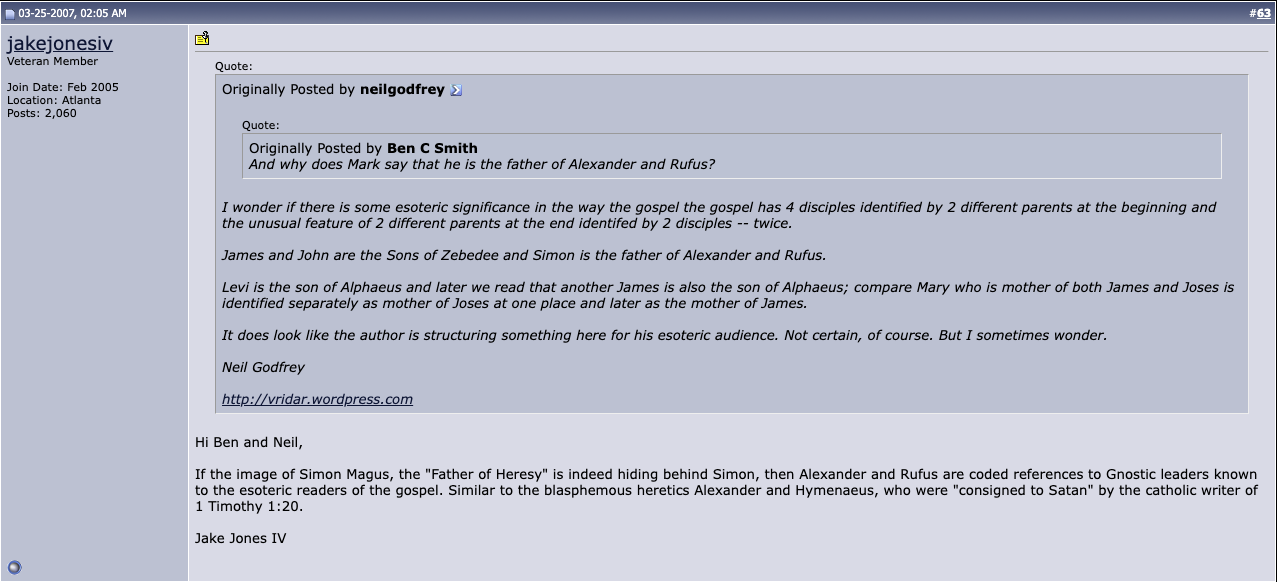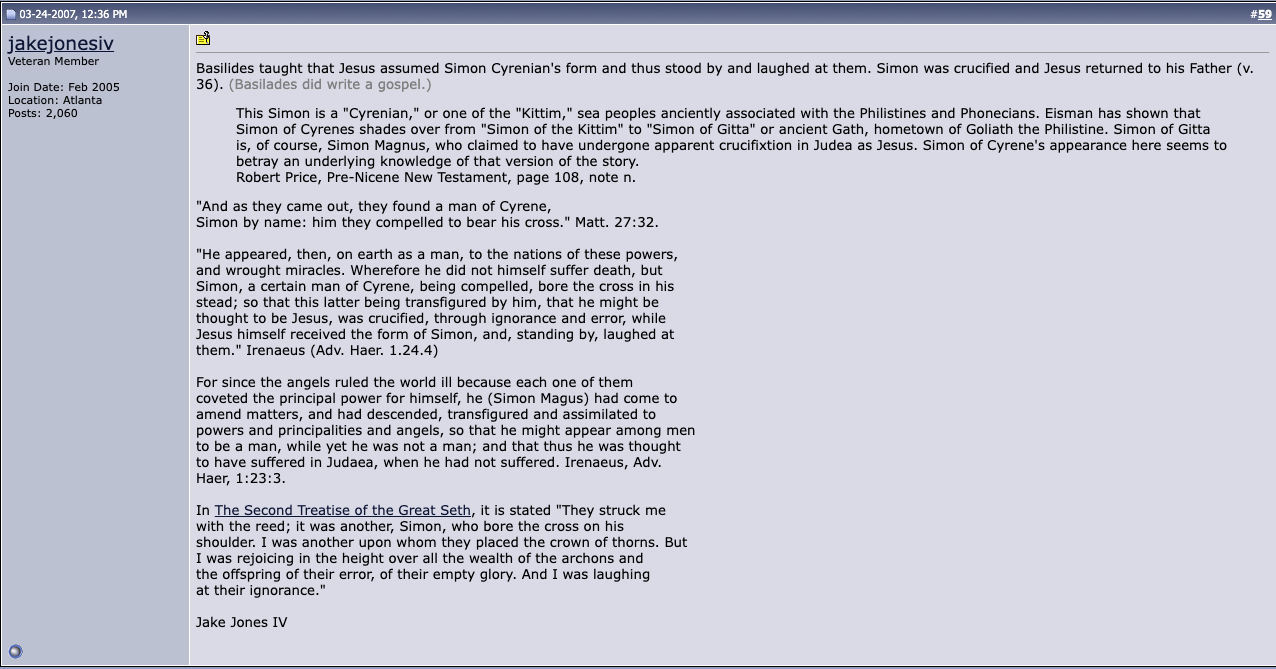How often have we found opinions expressed about those two sons of the cross-bearing Simon of Cyrene, Alexander and Rufus, mentioned only in the Gospel of Mark? Usually we read that the author was giving a wink to his local readers who knew them personally. But these readers all turned and smiled at the pair in their midst when the passage was read because no other gospel mentions them. The reason, we are commonly assured, is that the later authors did not know who they were so dropped them from their crucifixion narratives.
It’s a nice story, but surely a little reflection exposes it as false as the Tooth Fairy or Santa Claus. Did the authors following Mark personally know all of the characters mentioned by Mark? Did that personal ignorance lead them to drop any mention of them from their versions of events? Does not our experience with obscure figures in ancient literature teach us that rather than remove scenes that seem too sparse later authors prefer to augment them, to invent details to make stick figures more rounded? Compare, for instance, how the unnamed centurion plunging a spear into Jesus’ side in John’s gospel was later given a name and whole anecdotes were filled out about him.
Meanwhile, what are we to make of Alexander and Rufus, the sons of Simon of Cyrene?
A certain man from Cyrene, Simon, the father of Alexander and Rufus, was passing by on his way in from the country, and they forced him to carry the cross. — Mark 15:21
Are they added because of their symbolism? A Jewish name being the father of a Greek and a Roman name? It certainly looks like an enticing idea — all nations represented at the moment of the crucifixion. Or do they represent gnostic leaders? Or are they figures recalling the destruction of the Jews in wars, as proposed by Andreas Bedenbender? There have been many proposals and many discussions in print and online. I once pointed to them to remark on what I saw as literary bookend patterns in Mark.
But what if….. what if they were never part of the Gospel of Mark when it was composed but were later additions that had no relevance to the gospel at all?
Bruno Bauer introduced me to that possibility and I was compelled to consult the source that led him to his doubts. In a footnote in the final volume of his critique of the gospel narrative he wrote:
The further specification, “the father of Alexander and Rufus,” is an excess that is unfamiliar to Mark. It is an addition that a much later reader inserted. The two names are arbitrarily taken from the letters of the New Testament. (p. 291, translation)
How could he say such a thing about a question that has puzzled and exercised so many minds and generated so many theories? Bauer frequently critically cites Christian Gottlob Wilke so back to his 1838 work on the first gospel I turned.
Wilke believed “Bartimaeus” was not a name given to the blind man Jesus healed in the original author of the Gospel of Mark. The original text simply called him a “blind man”. If he had been known by a certain name he would not subsequently (10:49) have been simply referred to as “the blind man”. (If that is correct, we are following another rabbit hole if we use Bartimaeus to decipher Plato’s influence coded in the gospel.)
Then Wilke writes about the words in Mark 15:21, “the father of Alexander and Rufus”, saying that they . . .
. . . do not belong to the original text. Had Simon been thus more particularly designated, how would it have been previously stated that “a certain man of Cyrene” was compelled? (The readers who knew the man did not need the stipulation that he was of Cyrene, and for those who did not know him the latter was sufficient, nay, it is evident from it that it was the very thing which should have substituted for the name). (p. 673, translation)
He continues by noting a similar case for Levi being designated a “son of Alphaeus” in Mark 3. If he is correct there, that demolishes another set of theories such as those of Dale and Patricia Miller.
But Wilke does have a point. The way “father of Alexander and Rufus” is introduced is not the typical way one would introduce a new figure who is supposedly recognized by the readers.
Whatever the reality, one point that we are reminded of here: our earliest surviving texts are far removed from the originals. We cannot guarantee “every jot and tittle” has been preserved without some sort of corruption. We do know that copyists for innocent reasons and for more malign motives did sometimes edit what they copied.
We do not have sound foundations on which to base any discussion that relies upon a conviction that specific words and names were part of the original documents — unless we have early independent supporting evidence to give us such assurance.
Bauer, Bruno. Kritik der evangelischen Geschichte der Synoptiker und des Johannes. Vol. 3. 3 vols. Hildesheim ; New York : Olms, 1974 [1842]. http://archive.org/details/kritikderevangel0003baue.
Wilke, Christian Gottlob. Der Urevangelist oder exegetisch kritische Untersuchung über das Verwandtschaftsverhältniss der drei ersten Evangelien. Dresden ; Leipzig : Gerhard Fleischer, 1838. http://archive.org/details/derurevangelisto0000wilk.


